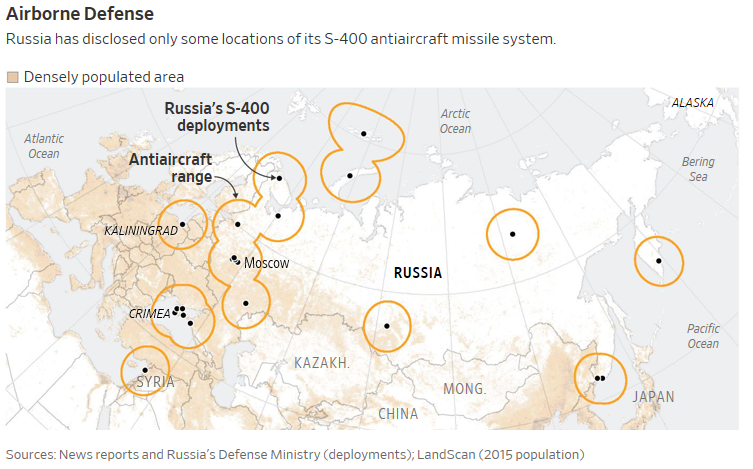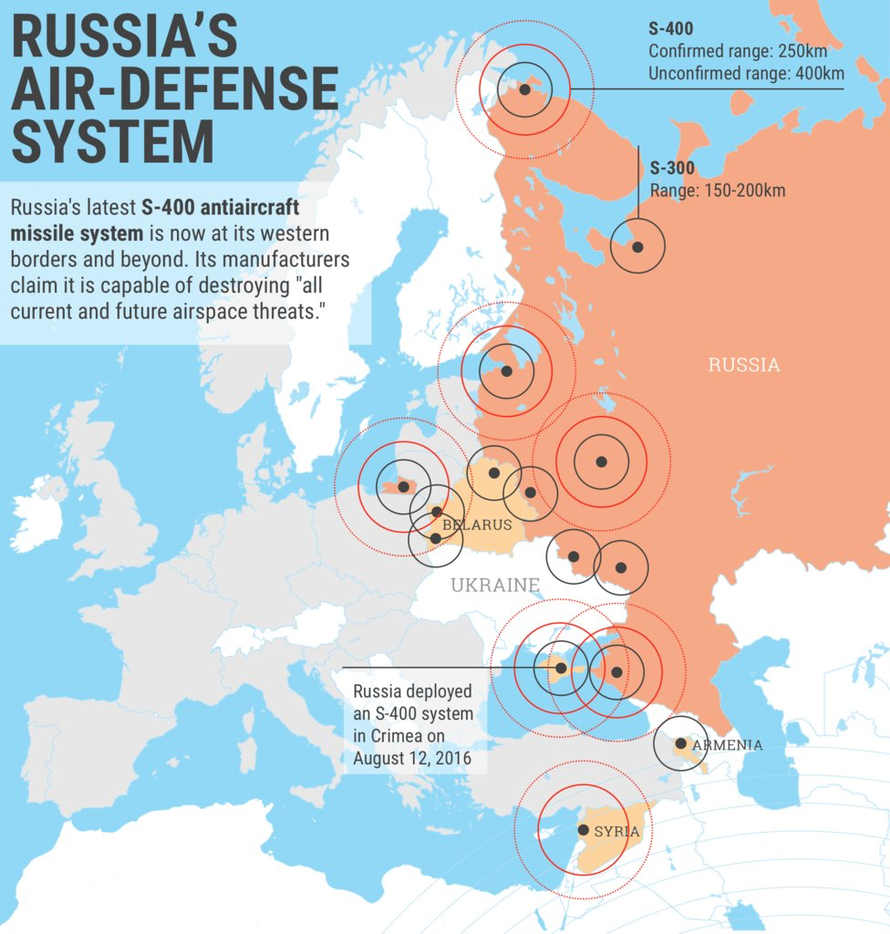As the West has for the past two years distracted itself and obsessed over claimed Russian election meddling and those sinister online “disinformation campaigns,” the Kremlin has been busy establishing air superiority in places US aircraft could at one time operate with impunity.
According to a new lengthy report in the Wall Street Journal Russia’s S-400 antiaircraft missile system, which much of the western public has recently begun to hear about in the context of Syria, is now “changing the calculus of the U.S. and its allies in potential hot spots” as Russia is erecting a “new Iron Curtain” in the form of a series of effective and far reaching anti-air defenses stretching from the Arctic to the Middle East.
For starters, the S-400 system’s stealth-detecting radar system is able to cast a broad net around the Eastern Mediterranean from its Russian base positioning in Syria, and is further linked up to “a ring of air defenses” that stretches “North from Syria, along the borders of Eastern Europe and rounding the Arctic Circle to the east,” according to the report.
Though not yet tested in battle, the Pentagon itself has admitted the necessity of changing flight routes and where it can operate in terms of deploying aircraft, which is the most significant revelation in the WSJ report:
The Pentagon acknowledged that S-400 batteries in Syria have forced adjustments to coalition air operations, but it contended the U.S. in general still maintains freedom of movement in the air. “We can continue to operate where we need to be,” a U.S. defense official said.
The White House revamped its National Security Strategy in late 2017 to account for the new challenge. Russia is “fielding military capabilities designed to deny America access in times of crisis and to contest our ability to operate freely,” a report said. “They are contesting our geopolitical advantages.”
And a further similar admission is found in a Congressional report produced by a bipartisan commission to evaluate White House defense strategy. The commission found, as cited in the WSJ, that Russia is “seeking regional hegemony and the means to project power globally,” and that this was already “diminishing U.S. military advantages and threatening vital U.S. interests.”

Though Russian military spending and capability is still dwarfed by both the United States and China (Russia’s defense budget is about a tenth the size of the Pentagon’s), the Kremlin’s strategic deployment of these systems to counter US power has been enough to put Washington on notice, and is driving fears the S-400’s deadly reach could proliferate, as it already has in China and India, and with prospective deals in the works with Saudi Arabia and Turkey.
If as the WSJ acknowledges the event that kickstarted the S-400’s deployment far outside Russia’s borders was the Syrian war, which saw an embattled Assad invited allied Russian forces into the country in 2015, then Washington and its allies can look no further than themselves in terms of blame. As both Putin, Assad, and at rare moments of frankness some US officials themselves have acknowledged, Russian forces entered Syria in reaction to the West-Gulf alliance’s covert war of regime change which empowered al-Qaeda and ISIS forces poised to take Damascus.
The result of this for US dominance across the Atlantic and Pacific oceans? WSJ finds, echoing the Russian conclusion:
As Russia fills orders, the expanding S-400 footprint creates barriers that threaten decades of unchallenged U.S. air superiority in the Middle East, the Arctic and parts of Asia. By selling the S-400 to other countries, Russia spreads the cost of limiting U.S. forces.
“Russia doesn’t want military superiority, but it has ended the superiority of the West or the U.S.,” said Sergey Karaganov, a foreign-policy adviser to Mr. Putin. “Now, the West can no longer use force indiscriminately.”
To be predicted the Pentagon is still touting its global dominance, a fact disputed by few, but perhaps soon to come up against the increasingly expansive reach of the S-400, especially if Turkey and Saudi Arabia actually end up acquiring them, something Washington will continue to work towards preventing.
The Pentagon told the WSJ in response to the question of Russia’s growing air defense capabilities: “The U.S. remains the pre-eminent military power in the world and continues to strengthen relationships with NATO allies and partners to maintain our strategic advantage,” said Pentagon spokesman Eric Pahon. “The U.S. and our allies have quite a few measures at our disposal to ensure the balances of power remain in our favor.”
via ZeroHedge News http://bit.ly/2Mruclr Tyler Durden
